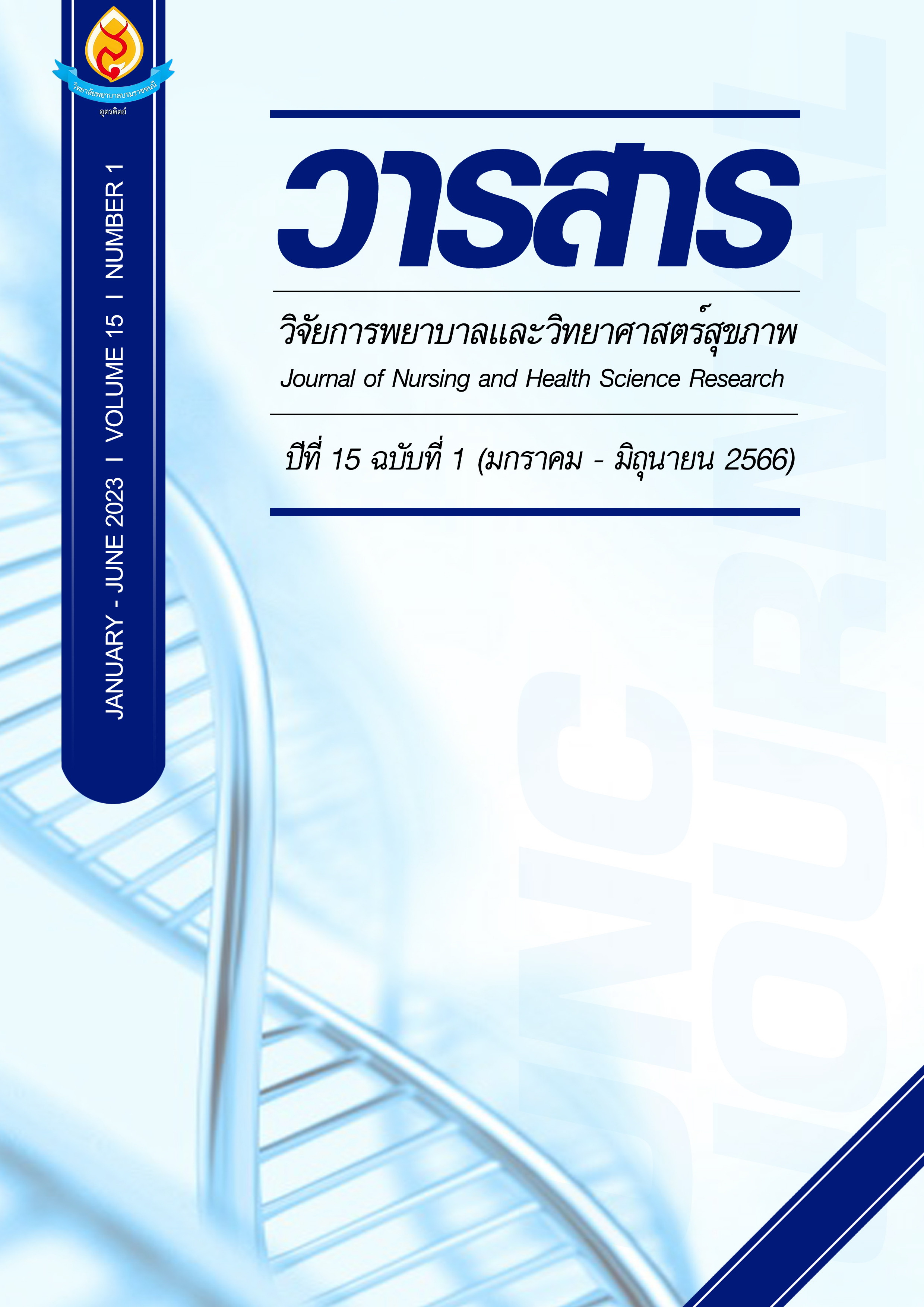ปัจจัยทำนายพฤติกรรมการควบคุมระดับน้ำตาลในเลือดของผู้ป่วยโรคเบาหวานชนิดที่ 1 ในโรงพยาบาลสังกัดกระทรวงกลาโหม
Main Article Content
บทคัดย่อ
การศึกษาเชิงพรรณนานี้มีวัตถุประสงค์เพื่อศึกษาปัจจัยทำนายพฤติกรรมการควบคุมระดับน้ำตาลในเลือดของผู้ป่วยโรคเบาหวานชนิดที่ 1 กลุ่มตัวอย่างเป็นผู้ป่วยโรคเบาหวานชนิดที่ 1 ที่รับบริการในโรงพยาบาลสังกัดกระทรวงกลาโหม อายุตั้งแต่ 18 ปีขึ้นไป จำนวน 135 คน ซึ่งสุ่มโดยวิธีการสุ่มอย่างง่าย เก็บข้อมูลโดยใช้แบบสอบถามที่พัฒนาตามกรอบแนวคิด PRECEDE Framework
ผลการศึกษาพบว่าปัจจัยนำ (เพศ ระยะเวลาการเจ็บป่วยด้วยโรคเบาหวานชนิดที่ 1 ความรู้เกี่ยวกับโรคเบาหวานชนิดที่ 1และการควบคุมระดับน้ำตาลในเลือด ทัศนคติต่อการเจ็บป่วยด้วยโรคเบาหวานชนิดที่ 1 และการควบคุมระดับน้ำตาลในเลือด) ปัจจัยเอื้อ (ความสะดวกในการเข้าถึงบริการ) และปัจจัยเสริม (การได้รับแรงสนับสนุนทางสังคม) มีความสัมพันธ์กับพฤติกรรมการควบคุมระดับน้ำตาลในเลือดอย่างมีนัยสำคัญทางสถิติ (p-value < .05) และความรู้เกี่ยวกับโรคเบาหวานชนิดที่ 1 และการควบคุมระดับน้ำตาลในเลือด การได้รับแรงสนับสนุนทางสังคม สามารถร่วมทำนายพฤติกรรมการควบคุมระดับน้ำตาลในเลือดอย่างมีนัยสำคัญทางสถิติ (p-value < .01) โดยมีค่าความแปรปรวนในการทำนายร้อยละ 45.80 (R 2 = .458, p-value < .01) ผลการศึกษามีข้อเสนอแนะในการส่งเสริมพฤติกรรมการควบคุมระดับน้ำตาลในเลือดในกลุ่มผู้ป่วยโรคเบาหวานชนิดที่ 1 โดยการให้ความรู้เกี่ยวกับการจัดการตนเองเมื่อเป็นโรคเบาหวานชนิดที่ 1 และการจัดการภาวะแทรกซ้อน การเพิ่มแรงสนับสนุนทางสังคมแก่ผู้ป่วยโรคเบาหวานชนิดที่ 1 และครอบครัว การจัดกิจกรรมกลุ่มแลกเปลี่ยนประสบการณ์ระหว่างผู้ป่วยและครอบครัว การส่งต่อการดูแลรักษาจากห้องตรวจผู้ป่วยเด็กไปผู้ใหญ่ การเยี่ยมติดตามที่บ้าน การให้ข้อมูลข่าวสารและชี้แนะแหล่งประโยชน์ที่เกี่ยวข้องกับการดูแลตนเองเพื่อควบคุมระดับน้ำตาลในเลือดของผู้ป่วยโรคเบาหวานชนิดที่ 1
Article Details

อนุญาตภายใต้เงื่อนไข Creative Commons Attribution-NonCommercial-NoDerivatives 4.0 International License.
บทความหรือข้อคิดเห็นใดใดที่ปรากฏในวารสารวิจัยการพยาบาลและวิทยาศาสตร์สุขภาพ เป็นวรรณกรรมของผู้เขียน ซึ่งบรรณาธิการหรือสมาคมศิษย์เก่า ไม่จำเป็นต้องเห็นด้วย และบทความที่ได้รับการตีพิมพ์เผยแพร่ถือเป็นลิขสิทธิ์ของวารสารวิจัยการพยาบาลและวิทยาศาสตร์สุขภาพ
เอกสารอ้างอิง
Almeda-Valdes, P et al. (2019). Factors associated with insulin nonadherence in type 1 diabetes mellitus patients in Mexico. International Journal of Diabetes & Metabolism, 25, 139- 147.
Aramwit, P. & Satirapoj, B. (2013). Glycemic control in diabetic patients on long-term maintenance dialysis. InTech, 153-191.
Amsberg, S., Wijk, I., Livheim, F. , Toft, E., Johansson, U.B. & Anderbro, T. (2018). Acceptance and commitment therapy (ACT) for adult type 1 diabetes management: study protocol for a randomized controlled trial. BMJ Open, 8, 1-7.
Archinkova, M., Konstantinova, M., Savova, R., Lotova, V., Petrova, C., Kalinka, K., Popova, G., Koleva, R., Boyadzhiev, V. & Mladenov, W. (2017). Glycemic control in type 1 diabetes mellitus among Bulgarian children and adolescents: the results from the first and the second national examination of HbA1c. Biotechnology & Biotechnological Equipment, 31(6), 1198-1203.
Atkinson, M.A., Eisenbarth, G.S. & Michels, A.W. (2014). Type 1 diabetes. HHS Public Access, 383(9911),69-82.
Association of Diabetes Educators. (2019). Type 1 diabetes in adults. Retrieved (2021, July 18). from http://www.thaide.org. (in Thai).
Braffett, H.B., Rice, M.M., Young, A.H. & Lachin, M.J. (2019). Mediation of the association of smoking and microvascular complications by glycemic control in type 1 diabetes. Journal PLOS ONE, 14(1), 1-4.
Borhani, M., Rastgarimehr, B., Shafieyan, Z., Mansourian, M., Hoseini, S. M., Arzaghi, S. M., Qorbani, M., Rezapoor, A., Asayesh, H., Charkazi, A. & Ansari, H. (2015). Effects of predisposing, reinforcing and enabling factors on self-care behaviors of the patients with diabetes mellitus in the Minoodasht city, Iran. Journal of diabetes and metabolic disorders, 14, 27.
Carlsund, A. & Soderberg, S. (2018). Living with type 1 diabetes as experienced by young adults. Nursing open, 6(2), 418–425.
Clinical Practice Guidelines for Diabetes. (3th ed.). (2017). Pathum Thani: Romyen Media. (in Thai).
Daniel. W. W. & Cross. C. L. (2014). Biostatistic: basic concepts and methodology for the health sciences. (10th ed.). Singapore: John Wiley & Sons Inc.
Deerochanawong, C. & Ferrario, A. (2013). Diabetes management in Thailand: a literature review of the burden, costs, and outcomes. Globalization and health, 9, 11.
Diabetes Educators Association. (2019). Type 1 diabetes in adult. Retrieved (2021, July 18). from https://www.thaide.org. (in Thai).
Division of Non-Communicable Diseases, Department of Disease Control, Ministry of Public Health. (2019). Diabetes situation report. Retrieved (2021, July 18). from https://ddc.moph.go.th/. (in Thai)
Dumrisilp, T., Supornsilchai, V., Wacharasindhu, S., Aroonparkmongkol, S. & Sahakitrungruang, T. (2017). Factors associated with glycemic control in children and adolescents with type 1 diabetes mellitus at a tertiary-care center in Thailand: a retrospective observational study. Asian Biomedicine, 11(6), 443-450.
Hendricks, M., Monaghan, M., Soutor, S., Chen, R. & Holmes, C. S. (2013). A profile of self-care behaviors in emerging adults with type 1 diabetes. The Diabetes educator, 39(2), 195– 203.
Jiawiwatkul, A. (2019). Research tools and tool quality inspection. Retrieved (2021, July 18). from https://www.priv.nrct.go.th. (in Thai).
Kalampakorn, S. (2013). Application of the concept. and theories in health promotion and prevention Diseases in the community. The Faculty of Public Health Mahidol University, Health Promotion and Disease Prevention in the Community: Application of Theory to Practice. (in Thai).
Likitmaskul, S. (2017). Type 1 diabetes in Thai children. Retrieved (2021, July 18).from www.thaipediatrics.org. (in Thai).
Nejhaddadgar, N., Ebadifard Azar, F., Solhi, M. & Amani, F. (2016). Effects of predisposing, reinforcing and enabling factors on the self-care behaviors of patients with diabetes mellitus. Health Education and Health Promotion, 4(3), 37-45
Nuntarakchaikul, P. (2015). Pediatric diabetic patients in Surat Thani Hospital. District Medical Journal 11, 29(3), 353-364. (in Thai).
Noorani, M., Ramaiya, K. & Manji, K. (2016). Glycaemic control in type 1 diabetes mellitus among children and adolescents in a resource limited setting in Dar es Salaam - Tanzania. BMC endocrine disorders, 16(1), 29-35.
Powwattana. A. (2018). PRECEDE-PROCEED model in synthesis of concepts, theory and empirical evidence. (1st ed.). Bangkok: Danex Inter Corporation. (in Thai).
Rodchuen, M. (2010). Preliminary sampling techniques. Retrieved (2021, July 18). from http:// www.manachai.cmustat.com. (in Thai).
Salih, K.H. (2019) Factors affecting glycemic control in type 1 diabetes mellitus among children in Sulaimani governorate, The Iraq Medical Journal, 8(2), 40-49
Sarinnaphakorn, V. (2014). Care of patients with difficult-to-treat diabetes. (1st ed.). Bangkok: Krungthep Vejsarn. (in Thai).
Tangsrikiatkul, P. (2018). Service plan NCD. Service system arrangement and care network.Type 1 diabetes. Retrieved (2021, July 10). from https://www.nhso.go.th/. (in Thai).
Tracy, E. L., Berg, C. A., Baker, A. C., Mello, D., Litchman, M. L. & Wiebe, D. J. (2019). Health-risk behaviors and type 1 diabetes outcomes in the transition from late adolescence to early emerging adulthood. Children's health care. journal of the Association for the Care of Children's Health, 48(3), 285–300.
Trepatchayakorn, S., Supornsilchai, V., Wacharasindhu, S., Aroonparkmongkol, S. & Sahakitrungruang, T. (2017). Trends and characteristics of childhood diabetes in a tertiary care center in Thailand. Asian Biomedicine, 8(6), 707-715.
Viklund, G. & Örtqvist, E. (2014) Factors predicting glycemic control in young persons with type 1 diabetes, European Diabetes Nursing, 11(3), 75-78.
Vijara, V. & Polamaung, W. (2013). Hyperglycemic crisis in Prapokklao Hospital. Journal of the Center for Clinical Medicine Education: Phrapokklao Hospital, 30(2), 133-145. (in Thai).
Wongdee, K., Krishnamra, N. & Charoenphandhu, N. (2017). Derangement of calcium metabolism in diabetes mellitus: negative outcome from the synergy between impaired bone turn over and intestinal calcium absorption. Journal of Physiological Sciences, 67(1),71–81.
Yazidi, M., Chihaoui, M., Chaker, F., Rjeb, O. & Slimane, H. (2016). Factors predicting glycemic control in type 1 diabetic patient. Open Medicine Journal, (3), 153-158


